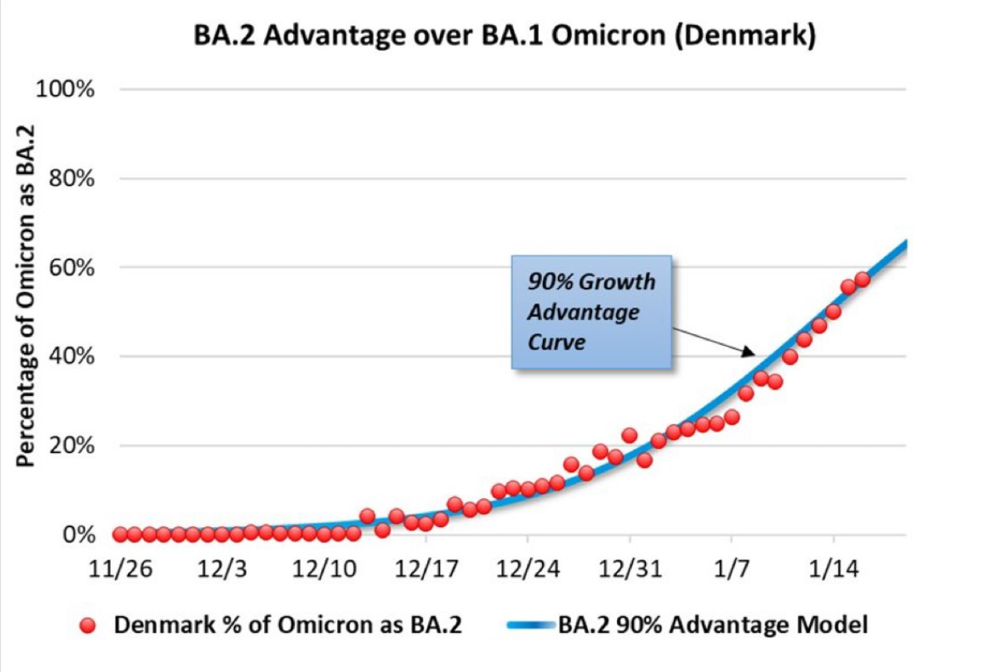Stopping Variants Means Stopping Transmission

Rapidly growing Omicron subvariant BA.2 reminds us that the impact of ongoing mutagenesis of SARS-CoV-2 on human health and activity is unpredictable, and that variants spread through a connected world more rapidly than current reporting systems can observe them.
We must understand our weaknesses along with our strengths. We are incapable of accurately predicting the effect of mutations. However, we are capable of slowing mutations by reducing the rate of transmission or achieving elimination.
What’s Endemicity Like?
Endemic diseases 100 years ago in the US included: Smallpox, Malaria, Polio, Measles, Rubella, Diphtheria.
COVID-19: Endemic doesn’t mean harmless. Aris Katzourakis. (Nature)
“Yes, common colds are endemic. So are Lassa fever, malaria and polio. So was smallpox… In other words, a disease can be endemic and both widespread and deadly.”
“Thinking endemicity is both mild and inevitable is more than wrong, it is dangerous: it sets humanity up for many more years of disease, including unpredictable waves of outbreaks.”
“It is more productive to consider how bad things could get if we keep giving the virus opportunities to outwit us. Then we might do more to ensure that this does not happen.“
Children and COVID
Data needed for alarming rise in pediatric MIS-C and Post-COVID Encephalopathy

Multisystem inflammatory syndrome in children (MIS-C, or PIMS) is a condition where different body parts can become inflamed, including the heart, lungs, kidneys, brain, skin, eyes, or gastrointestinal organs, appearing a few weeks following a pediatric infection with SARS-CoV-2, many times with mild or no symptoms during the acute phase. Case rates are approximately one in a few thousand infections, but due to the large numbers of children being infected, over 5,000 kids have already been hospitalized with MIS-C in the USA alone, and more than 50 of them died.

Due to the typical delay of a few weeks between infection and hospitalizations, only now do we see the first signs of the Omicron wave’s impacts on children, and it is not mild. There are some concerning early reports from around the world about a fast rise in MIS-C in the last two weeks, coupled with reports about a rise in Post Covid Encephalopathy in kids and requests for data gathering for rapid analysis of this risk.Clinicians: please share presumed post-COVID encephalopathy cases encountered in your practice with the Pediatric Infectious Diseases Society (PIDS) survey
Guidance
University COVID Best Practices Winter/Spring 2022 – (WHN + CAG)
Resources
OMICRON / COVID Consequences
Graphs comparing BA.1 vs BA.2 in various countries. (Ryan Hisner)
Reminder: SARS-CoV-2 is a lethal coronavirus. (Dr David Berger)
Hospitalizations exploding among Utah infants and children younger than 5 infected with Omicron. (Salt Lake Tribune)
South Africa: “Younger persons have become responsible for an increasingly large proportion of the persons testing positive for COVID-19 since the emergence of the Delta variant. This is even more evident since the emergence of the Omicron variant.”
Special Public Health Surveillance Bulletin. (NICD)
Hong Kong to cull hamsters over concerns of animal-to-human COVID-19 transmission. (Reuters), and COVID infected lions in South Africa prompt variant alert. (Bloomberg Quint)
International tourism brings Omicron to Pacific nations Fiji, Kiribati, Solomon Islands, Samoa. Kiribati and Samoa implement rare lockdowns after travelers test positive. (NPR)
Policy
Rosy assumptions endanger public health—policymakers must act now to shape the years to come. Endemic doesn’t mean harmless. (Nature)
The Omicron wave is too damaging to ‘let it rip.’ Can Australia be certain that each new variant will be less deleterious than the previous one? (Peter Lewis-Hughes)
The successful control of the epidemic spread of SARS-CoV-2 requires synergistic public health measures tailored in response to the airborne, evasive, infectious properties of the pathogen. Why Covid-19 will never become endemic. (The Saturday Paper)
Data: Tracking excess mortality across countries. (eLife)
Structural barriers to the in-depth assessment of post-acute neurological sequelae of COVID-19. A call for advancing healthcare equity. (Nature) Harvard stops protecting students in new guidelines: “Students whose direct roommate tests positive may apply for alternative housing if they are asymptomatic and have tested negative… Alternative housing is limited and is not guaranteed.” (Harvard Crimson)
Economy
Panic buying empties grocery store shelves.
Why are US grocery stores out of everything again? (Bloomberg)
Corbevax Creator: “In the context of a global emergency, you need to be a little more altruistic.” A patent-free vaccine may offer solutions to accessibility and supply challenges worldwide. (EL PAÍS)
Following the outbreak, we find an unprecedented drop in maritime mobility, across all categories of commercial shipping. COVID-19 impact on global maritime mobility. (Nature)
Mitigation
Appropriate use of Rapid Diagnostic Testing for the identification of infectious COVID-19 windows. (NEJM), and, Study finds false positive results in RDT are rare. (JAMA)
N95s offer the best protection against airborne viruses of any disposable mask.
Why most should be wearing N95 masks. (WP)
COVID diagnosis without need for hospitalization still associated with significant mobility and functional impairments in adults over 50 years old. Individuals with COVID-19 not requiring hospitalization experienced deficits in functional mobility. (JAMA Network Open)Documented case of Delta airborne transmission underscores the importance of indoor air quality in controlling disease. Airborne Transmission of SARS-CoV-2 Delta Variant within Tightly Monitored Isolation Facility, New Zealand (Aotearoa). (Emerging Infectious Diseases)
In Community,
-The WHN